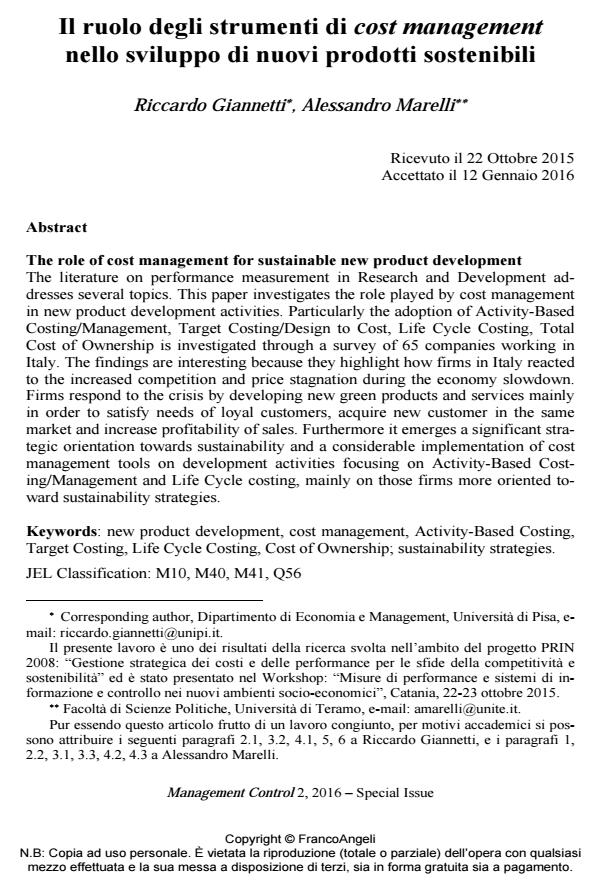Il ruolo degli strumenti di cost management nello sviluppo di nuovi prodotti sostenibili
Titolo Rivista MANAGEMENT CONTROL
Autori/Curatori Riccardo Giannetti, Alessandro Marelli
Anno di pubblicazione 2016 Fascicolo 2016/2
Lingua Italiano Numero pagine 36 P. 33-68 Dimensione file 492 KB
DOI 10.3280/MACO2016-002003
Il DOI è il codice a barre della proprietà intellettuale: per saperne di più
clicca qui
Qui sotto puoi vedere in anteprima la prima pagina di questo articolo.
Se questo articolo ti interessa, lo puoi acquistare (e scaricare in formato pdf) seguendo le facili indicazioni per acquistare il download credit. Acquista Download Credits per scaricare questo Articolo in formato PDF

FrancoAngeli è membro della Publishers International Linking Association, Inc (PILA)associazione indipendente e non profit per facilitare (attraverso i servizi tecnologici implementati da CrossRef.org) l’accesso degli studiosi ai contenuti digitali nelle pubblicazioni professionali e scientifiche
The literature on performance measurement in Research and Development addresses several topics. This paper investigates the role played by cost management in new product development activities. Particularly the adoption of Activity-Based Costing/Management, Target Costing/Design to Cost, Life Cycle Costing, Total Cost of Ownership is investigated through a survey of 65 companies working in Italy. The findings are interesting because they highlight how firms in Italy reacted to the increased competition and price stagnation during the economy slowdown. Firms respond to the crisis by developing new green products and services mainly in order to satisfy needs of loyal customers, acquire new customer in the same market and increase profitability of sales. Furthermore it emerges a significant strategic orientation towards sustainability and a considerable implementation of cost management tools on development activities focusing on Activity-Based Costing/Management and Life Cycle costing, mainly on those firms more oriented toward sustainability strategies.
Parole chiave:New product development, cost management, Activity-Based Costing, Target Costing, Life Cycle Costing, Cost of Ownership; sustainability strategies.
Jel codes:M10, M40, M41, Q56
- The role of Eco-control in the implementation of Sustainable Business Models Giacomo Fabietti, Francesca Trovarelli, in MANAGEMENT CONTROL 3/2016 pp.141
DOI: 10.3280/MACO2016-003008 - Life cycle costing. Problematiche e soluzioni metodologiche e organizzative nella sua implementazione per la sostenibilità ambientale Marco Vacca, in MANAGEMENT CONTROL 2/2024 pp.141
DOI: 10.3280/MACO2024-002007 - From cost control to cost management: How is the current state of the Italian context? Anna Lucia Missaglia, Alberto Bubbio, Dario Gulino, in MANAGEMENT CONTROL 1/2024 pp.203
DOI: 10.3280/MACO2024-001010
Riccardo Giannetti, Alessandro Marelli, Il ruolo degli strumenti di cost management nello sviluppo di nuovi prodotti sostenibili in "MANAGEMENT CONTROL" 2/2016, pp 33-68, DOI: 10.3280/MACO2016-002003